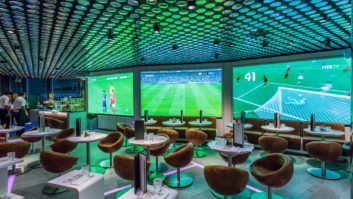In a world where it feels increasingly unwise to take anything for granted, it was reassuring recently to encounter research indicating that demand for professional displays and projectors remains very robust. While LCD displays continue to perform well, sales of LED displays are growing as costs begin to decrease. Meanwhile, the installation and large venue segment “remains resilient” for front projection, according to Futuresource Consulting lead market analyst David Thompson.
“There is still a clear demand for high-quality projection solutions in immersive experiences and other specialised applications,” he says. “Projection technology continues to deliver unparalleled benefits in areas where other formats cannot compete, particularly in high-demand creative fields.”
There’s much more on projector market developments in our special focus boxout (page 27), but the dynamism of the display market – especially around LED-related developments – means that it’s the main focus of our coverage this time. Following on from an ISE show rich in innovative products in this field, we’ll examine the design drivers and growth applications for pro displays; the factors, such as versatility and cost-efficiency, that are driving customer choices; and the newer trends, including increased expectations around sustainability, that are destined to shape the market over the next few years.
 As a company active in both displays and projectors, Sharp NEC Display Solutions is ideally positioned to identify some of key design drivers in 2025. Senior product manager Gerd Kaiser remarks: “Both LCD large format displays and laser projection are already well established and at a very high-performance level, making them hard to improve upon. The innovation taking place in these categories focuses on further enhancements to the user experience and improving energy efficiency. DVLED is becoming more accessible for budget-conscious applications and is now a genuine alternative for mainstream installations demanding large surface visualisation in areas of bright ambient light.”
As a company active in both displays and projectors, Sharp NEC Display Solutions is ideally positioned to identify some of key design drivers in 2025. Senior product manager Gerd Kaiser remarks: “Both LCD large format displays and laser projection are already well established and at a very high-performance level, making them hard to improve upon. The innovation taking place in these categories focuses on further enhancements to the user experience and improving energy efficiency. DVLED is becoming more accessible for budget-conscious applications and is now a genuine alternative for mainstream installations demanding large surface visualisation in areas of bright ambient light.”
Dean Tsai, general manager of the projector & LED display Business Unit at ViewSonic, delineates a whole series of innovations, including “growing attention to COB (Chip-on-Board) technology, offering finer pixel pitch for superior image clarity in LED displays, as well as increasing demand for 4K resolutions in large-format visual solutions, enhancing detail, contrast and colour accuracy.”
Tsai also highlights some other, longer-term trends that continue to impact pro display developments, including a need for smaller, lighter and more compact solutions: “Customers increasingly prefer LED solutions in easier adoptable forms like all-in-one designs, including for reasons of easy installation, operation and maintenance.” Smooth running post-installation is another consideration as customers seek intuitive operation and management: “More displays offer instant access via remote control, LAN connection, and centralised system platforms as preferred.”
But while all of these factors feed into the mix, a review of some of the ISE 2025 launches suggests that energy efficiency is on its way to becoming priority number one for many customers. This is not hard to understand: energy prices remain extremely turbulent, and will probably become even more so in a world growing more unstable every week, while many organisations are now working to satisfy rigorous sustainability strategies. Hence there will be further refinements to various technologies underpinning LED.
SUSTAINABLE INSIGHTS
For ViewSonic, this trend towards organisations having improved sustainability goals is leading to a demand for several specific technologies and features, says Tsai: “Advanced energy-saving ICs that significantly reduce power consumption; adaptive brightness control and power management optimising energy use and ensuring efficiency without compromising visual performance; and increased use of recyclable materials in packaging.”
 Many eminent manufacturers placed an emphasis on energy efficiency with regard to their display technology presence at ISE this year – Christie among them. The company offered a chance for attendees to experience its MicroTiles LED technology with a video wall showcasing four pixel pitch options, ranging from 0.75mm to 1.5mm, in a single display. In addition, noted the manufacturer, “the latest advancements to MicroTiles LED cut power consumption by 40%”, while lower power consumption was also cited in reference to Core Series III.
Many eminent manufacturers placed an emphasis on energy efficiency with regard to their display technology presence at ISE this year – Christie among them. The company offered a chance for attendees to experience its MicroTiles LED technology with a video wall showcasing four pixel pitch options, ranging from 0.75mm to 1.5mm, in a single display. In addition, noted the manufacturer, “the latest advancements to MicroTiles LED cut power consumption by 40%”, while lower power consumption was also cited in reference to Core Series III.
Installation suggests to Christie Digital Systems’ director of product management, Joel St-Denis, that customers are increasingly prioritising power consumption: “Absolutely. It’s one of the biggest growing demands that’s happened in both projection and the LED space.”
For Sharp NEC, Kaiser draws attention to a display at ISE of Sharp LD-FE123 1.2mm fine pixel pitch models as part of an 8K, 3-segment LED installation. The deployment also demonstrated the energy-saving capabilities of Flip-Chip SMD (surface mount device) technology, wherein electrical components are mounted directly onto the surface of printed circuit boards.
“In the pro AV sector, sustainability is a significant purchasing criteria and this will become more and more prevalent; we are seeing large tenders requiring evidence of sustainable practices,” confirms Kaiser. “Companies are increasingly prioritising energy efficiency, to conserve energy and also to reduce operating costs. This is driving innovation, resulting in next generation tech which delivers improved efficiencies, such as new Flip-Chip SMD, which reduces power consumption and heat emission by up to 60 percent compared to conventional LED tech, as showcased at ISE.”
With Flip-Chip SMD, notes Sharp NEC on its website, energy savings can be expected not only from the display itself, but also from the “reduced requirement for air conditioning since the display is not emitting high levels of heat – the LED surface is cool to the touch”.
 Kaiser also highlights a noticeable increase in demand for the use of DVLED displays – which use arrays of micro-pixels emitting light and colour directly, circumventing the requirement for a backlight – across application areas. There is significant growth for DVLED technology, he says, especially in flagship retail, transportation, and premium meeting and reception spaces where, although constrained by budgetary factors, it is proving to offer “an impressive TCO” thanks to its extremely long-life cycle and impressive energy efficiency.
Kaiser also highlights a noticeable increase in demand for the use of DVLED displays – which use arrays of micro-pixels emitting light and colour directly, circumventing the requirement for a backlight – across application areas. There is significant growth for DVLED technology, he says, especially in flagship retail, transportation, and premium meeting and reception spaces where, although constrained by budgetary factors, it is proving to offer “an impressive TCO” thanks to its extremely long-life cycle and impressive energy efficiency.
Meanwhile, the reach of LED per se continues to expand. Tsai confirms that as the cost base comes down, there has been an increased appetite for LED products due to their “brighter visuals, better scalability, and seamless large-scale imagery.” Hence demand is strong in corporate (“increased adoption in lobbies, receptions, and conference rooms for enhanced brand presence”), education (“growing use in auditoriums and lecture halls for improved engagement and visibility”) and retail outlets and shopping malls (“for high-impact digital signage and advertising”).
LG Electronics’ display presence at ISE also evinced a strong level of demand across applications, with dedicated zones for business sectors including retail, corporate, education, transportation and hospitality. Noting its ability to meet “the diverse needs of B2B clients and enhance and expand the customer experience”, LG showcased its Kinetic LED display with AI technology; the LG MAGNIT micro LED displays, upgraded to improve “ease of installation, content compatibility and energy efficiency”; new high-brightness outdoor signage solutions featuring LG’s Anti-Discoloration technology; and a host of solutions for retail, corporate and education.
Park Hyoung-sei, president of the LG Media Entertainment Solution Company, remarked: “As a leader in the B2B market, our goal is to deliver innovative solutions that elevate the value of commercial, public and educational spaces, while also enabling transformative customer experiences and supporting the growth and success of our clients.”
BIG THINGS
Inevitably, our interviewees posited a host of predictions regarding the future of pro display technology – ranging from continued refinement of what we might term core principles, to increased efficiencies and entirely new approaches.
“Enhancements to the user experience will continue, pushing to achieve greater efficiencies will continue, but in terms of the next BIG thing, we should highlight an entirely new genre of energy efficient display technology – ePaper,” says Kaiser. “At zero energy consumption, ePaper is truly groundbreaking.”
 At ISE, Sharp/NEC introduced new larger sizes and an outdoor compatible solution for DOOH environments, where ePaper offers “exceptional potential” for the carbon neutral future of digital signage. “For static signage that changes frequently, ePaper is especially effective in high ambient light, making it the ideal replacement for paper posters, yet with all the benefits of digital signage,” adds Kaiser.
At ISE, Sharp/NEC introduced new larger sizes and an outdoor compatible solution for DOOH environments, where ePaper offers “exceptional potential” for the carbon neutral future of digital signage. “For static signage that changes frequently, ePaper is especially effective in high ambient light, making it the ideal replacement for paper posters, yet with all the benefits of digital signage,” adds Kaiser.
For ViewSonic, Tsai nominates three “next big things”, beginning with COX (Chip-on-Anything) technology. “COX technology enables flexible, ultra-thin, and transparent LED panels, with variants like COP, which uses flexible plastic for rollable and foldable panels, and COG, which incorporates glass for ultra-fine pixels and transparency,” he says. “These advancements unlock new possibilities for creative applications and immersive environments.”
AI POWER
Tsai is not alone in indicating that there will be more AI integration with display solutions as the various technologies stabilise. “AI-powered software enhances real-time image optimisation, refining colour, contrast, and brightness based on changing environmental conditions,” he says. “Automated content management dynamically adjusts visuals for advertising and presentations, creating interactive or more personalised experiences, while AI-driven predictive maintenance detects issues early, minimising downtime and ensuring long-term reliability.”
There is also an expectation of increased demand at some point for 8K, although at present adoption is being somewhat stymied by a dearth of native content. “Currently, demand is driven by broadcasting and high-end production, but as content availability grows and manufacturing costs decrease, wider adoption is expected,” says Tsai.
Of course, for all the refinements and diversification in LED technologies, there’s no doubt that the expense of implementing an LED wall can still be significantly higher than that of a projector-based installation, so it seems almost certain that the pressure on cost – especially at the lower end of the market – will intensify.
Christie’s Joel St-Denis observes: “Getting things that are good quality but less expensive is something I think will continue to trend up. Also, it’s a supply and demand thing. The more people you have wanting a smaller pixel pitch, for example, the more you’re going to have companies that are designing these new pixel pitches, which will drive more demand for LED manufacturers and the whole economy of scale will will end up trending the price down.”
As in every area of pro AV, innovation in display and projector technology has always had to be balanced out with an adherence to cost-effectiveness that is particularly essential in sectors such as retail. Right now, however, it appears that a pleasing sweet spot has occurred where the trajectories towards innovation and a more accessible cost-base have collided, allowing customers – regardless of sector and budget – to benefit from the latest advances in display technologies.






